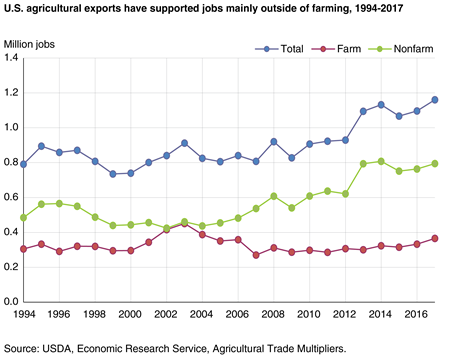U.S. Agricultural Exports Supported 1.2 Million Full-Time Jobs in 2017

U.S. agricultural exports support output, employment, income, and purchasing power in the overall domestic economy. ERS estimates that, in 2017, each dollar of agricultural exports stimulated another $1.30 in business activity. Thus, the $138 billion of agricultural products exported by the United States in 2017 produced an additional $179 billion in economic activity, for a total economic output of $317 billion.
Every $1 billion of U.S. agricultural exports in 2017 required approximately 8,400 American jobs throughout the economy. At $138 billion in 2017, agricultural exports required about 1.2 million full-time civilian jobs. These included 795,000 jobs in the nonfarm sector. Farmers’ purchases of fuel, fertilizer, and other inputs to produce commodities for export spur economic activity in the manufacturing, trade, and transportation sectors. Data processing, financial, legal, managerial, administrative, and many other types of services are also needed to facilitate the movement of export commodities. Consequently, U.S. agricultural exports support economic activity in both the farm and nonfarm sectors of the domestic economy.
In terms of employment growth, sectors outside of farming were the major beneficiaries of U.S. agricultural exports during 2004–17. Starting in 2004, the estimated numbers for farm and nonfarm jobs supported by agricultural exports diverged, with the latter accounting for a rising share of the total employment supported by agricultural exports. Although the number of farm jobs stabilized with a slight upward trend in 2007, nonfarm jobs were roughly double the number of farm jobs during 2007–17.
This growing importance of nonfarm jobs is consistent with the upward trend in the job numbers supported by nonbulk exports, such as processed foods and animal products, which rely on a broader range of businesses than bulk goods, such as soybeans, corn, and other feed grains. (Nonfarm businesses supported by nonbulk exports include food processing, services, and other manufacturing.) Thus, the composition of agricultural exports (bulk versus nonbulk) influences not only the total number of jobs but also the distribution of employment between the farm and nonfarm sectors. Nonbulk commodities account for the majority of the volume of U.S. agricultural exports and continue to support the majority of jobs dependent on agricultural exports. Most of those jobs are in nonfarm sectors.
Agricultural Trade Multipliers, by Wendy Zeng, Fengxia Dong, and Megan Husby, USDA, Economic Research Service, May 2023


